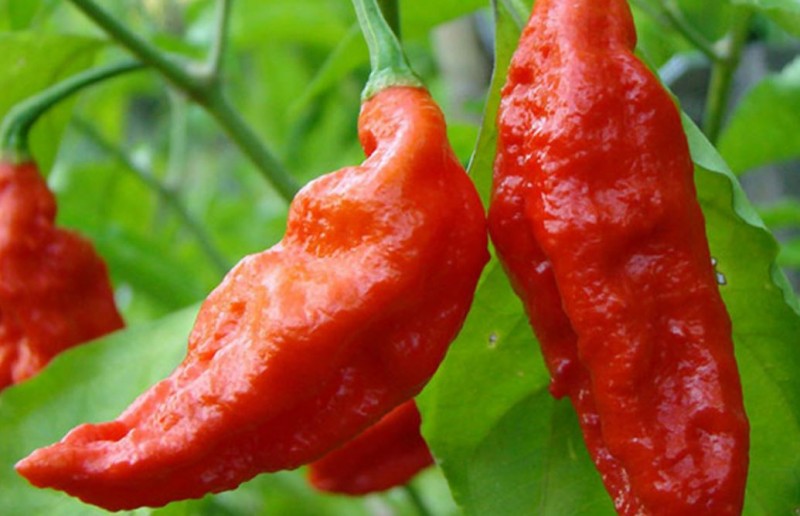
Introduction
If you're a fan of spicy food, you've probably heard of the Carolina Reaper. Known for its intense heat and fiery flavor, the Carolina Reaper has gained a reputation as the hottest chili pepper in the world. In this article, we'll delve into the fascinating world of this scorching pepper, exploring its origin, its heat level measured in Scoville Heat Units (SHU), and its impact on the culinary world.
The Origin of the Carolina Reaper
The Carolina Reaper was developed by Ed Currie, an American chili pepper farmer and founder of the PuckerButt Pepper Company. Through selective breeding and cross-pollination, Currie aimed to create the spiciest chili pepper in the world. The Carolina Reaper is a hybrid of a Pakistani Naga pepper and a Red Habanero.
The Scoville Scale: Understanding Heat Units
The Scoville Scale is a measurement of the heat or pungency of chili peppers. It was developed by pharmacist Wilbur Scoville in 1912 and is based on the concentration of capsaicin, the compound responsible for the heat in chili peppers. The higher the Scoville Heat Units (SHU), the hotter the pepper.
The Carolina Reaper's Scoville Heat Units (SHU)
The Carolina Reaper has an average heat level of over 1.5 million SHU, making it the undisputed champion in the world of chili peppers. To put this into perspective, a jalapeño pepper typically ranges from 2,500 to 8,000 SHU. The Carolina Reaper's extreme heat has made it a favorite among chili pepper enthusiasts seeking an intense culinary experience.
The Flavor Profile of the Carolina Reaper
Despite its scorching heat, the Carolina Reaper offers more than just pure spiciness. It has a fruity and slightly sweet flavor, which can be attributed to its genetic lineage. The pepper's unique taste, combined with its fiery nature, creates a thrilling sensory experience for those brave enough to try it.
Culinary Uses and Recipes with the Carolina Reaper
The Carolina Reaper is not just a novelty; it has found its way into various culinary creations. Chefs and home cooks alike use it to add a kick to their dishes, ranging from hot sauces and marinades to salsas, stews, and even desserts. When incorporating the Carolina Reaper into recipes, it is crucial to exercise caution and use it sparingly due to its extreme heat.
The Impact of the Carolina Reaper on the Chili Pepper Industry
The introduction of the Carolina Reaper has significantly impacted the chili pepper industry. Its record-breaking heat has sparked a trend of seeking ever hotter chili peppers, leading to a surge in the development of new super-hot varieties. The Carolina Reaper's popularity has also prompted an increase in the production of hot sauces and other spicy food products to cater to the growing demand.
Growing Your Own Carolina Reaper Plant
For those adventurous gardeners who want to experience the thrill of growing the Carolina Reaper, it is possible to cultivate the plant at home. However, it requires specific growing conditions, including ample sunlight, warm temperatures, and well-drained soil. Additionally, novice gardeners should be prepared for the challenges that come with nurturing such a fiery plant.
Safety Precautions When Handling the Carolina Reaper
It is essential to exercise caution when handling the Carolina Reaper due to its extreme heat. The capsaicin in the pepper can cause skin and eye irritation, so wearing gloves is highly recommended when handling it. Furthermore, it is crucial to avoid touching sensitive areas of the body, such as the eyes or face, after handling the pepper to prevent discomfort or injury.
The Carolina Reaper in Pop Culture
The Carolina Reaper has made appearances in various forms of pop culture, including food challenges, YouTube videos, and competitive eating events. Its reputation as the hottest chili pepper in the world has captured the attention of spice enthusiasts and generated a significant following online. The Carolina Reaper has become a symbol of extreme spiciness and adventure for chili pepper lovers worldwide.
Health Benefits and Risks Associated with the Carolina Reaper
While chili peppers like the Carolina Reaper can provide certain health benefits, such as boosting metabolism and releasing endorphins, their intense heat can also pose risks. Consuming excessively spicy foods can lead to digestive discomfort, heartburn, and even allergic reactions in some individuals. It is crucial to approach the Carolina Reaper with caution and consider personal tolerance levels when incorporating it into your diet.
Where to Find and Purchase Carolina Reaper Products
Carolina Reaper products, such as fresh peppers, hot sauces, and dried pepper flakes, can be found in specialty food stores, online marketplaces, and directly from chili pepper farms. However, due to the extreme heat of the pepper, it is essential to research reputable sources and ensure you are purchasing from trusted vendors to guarantee authenticity and quality.
The Future of the Carolina Reaper
As the Carolina Reaper continues to gain popularity, its future holds promise for further advancements in the realm of super-hot chili peppers. Breeders and chili enthusiasts are constantly striving to push the limits of spiciness, creating new varieties that may one day surpass the Carolina Reaper's heat level. The future of the Carolina Reaper and its impact on the culinary world is undoubtedly an exciting prospect.
Conclusion
The Carolina Reaper has rightfully earned its title as the hottest chili pepper in the world, boasting over 1.5 million Scoville Heat Units. With its fiery flavor and extreme heat, it has captured the attention of spice enthusiasts globally. Whether you're a seasoned chili pepper aficionado or someone looking to explore the world of hot peppers, the Carolina Reaper offers an unforgettable culinary adventure.
Transform Your Health: Embrace Healthy Meals and Limit Unhealthy Foods
The Art of Paella: Discovering the Delights of Spain's Iconic Dish
Ramen Revealed: Exploring the History, Varieties, and Irresistible Flavors of this Iconic Dish